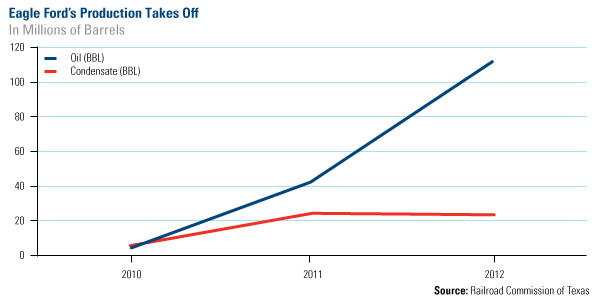Texas has seen incredible changes in oil production because of advancements in shale technology. From one 200-mile view at night, you can easily spot the urban areas of Dallas, Houston, San Antonio and Austin, but the strip just south of the Alamo City and U.S. Global Investors’ headquarters illuminates something else entirely: the bright lights of big oil generated by the Eagle Ford shale formation. 
In its new report pictured here, the University of Texas at San Antonio provides more than just a satellite view of oil production in the area.
First, take a look at Texas’ overall crude oil production during the past few decades. Since hitting about 2.6 million barrels of oil per day in 1981, production began slowly declining, bottoming to just over 1 million barrels per day during the early part of this century, according to the U.S. Energy Information Administration (EIA).
Over the past few years, though, daily production has gone vertical, with the state pumping out more than 2.2 million barrels each day. Production has grown so rapidly, that if Texas were a country, it would be the 13th largest oil-producing nation in the world, based on international crude oil output from November, says Mark Perry in his Carpe Diem blog. 
The primary driver of this incredible lift has been the Eagle Ford formation, an area 50 miles wide and 400 miles long. According to the UTSA’s Center for Community and Business Research, oil out of Eagle Ford has increased from about 5 million barrels to more than 110 million barrels in a matter of only two years. 
This huge boom in oil production has had a tremendous economic impact on Texas as well. UTSA’s report calculates that within a 20-county area, the Eagle Ford Shale added more than $61 billion in economic impact in 2012. This number includes 14 counties that have actively producing wells, along with six counties that experience indirect activity from the Eagle Ford area.
According to UTSA, Eagle Ford is expected to continue contributing to the area over the next several years. “The region will support 127,000 jobs and produce an economic impact of $89 billion for Texas in 2022,” says the report.
We believe these economic bright lights have created significant opportunities for natural resources investors. See how you can access this trend.
Read more:Download your copy of UTSA report here.
Read The Significant Impact of U.S. Oil Production.
See how investors can benefit from rising oil production.
By clicking the link above, you will be directed to a third-party website. U.S. Global Investors does not endorse all information supplied by this website and is not responsible for its content.
Please follow Money Game on Twitter and Facebook.